

WHY A THERMOSTATIC MIXING
VALVE ?
| According to the new European standard EN1717 (protection against pollution of potable water in water installations and general requirements of devices to prevent pollution by backflow), thermostatic mixing valves must be equipped with approved check valves. |
2
TYPES OF TECHNOLOGY : WAX ELEMENT AND BIMETALLIC STRIP
Products
with Wax element : MMV, TL117, T9107, T9715,
MINIMIXING + inset mixing valves T8175, T8147
The technique of these models is that of automatic regulation
via a cylindrical "slide valve", activated by a wax capsule up to
flowrates of approximately 40 l/min.
It is quite standard and competitive, but quickly reaches its limits beyond
40 l/min.
The hot and cold water inlets are located on other side of this "slide
valve”. When the water is too cold as regards the set point (upon opening),
a spring pushes the "slide valve" and closes the cold side and thus
opens the hot side completely.
As soon as the hot water comes in, the capsule expands and draws the "slide
valve” of the other side, closing the hot side and compressing the spring.
As the cold water then flows in again, the spring will bring the "slide
valve" to the hot side and reach the proper mixing temperature.
All these operations are carried out in less than 2 seconds. Should the pressure
vary, the same operation will be repeated.
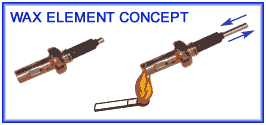
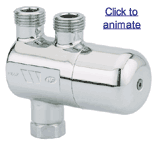
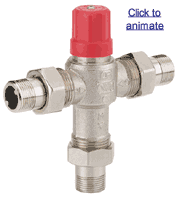
Products
with Bimetallic strip : ULTRAMIX TX91, TX92, TX93,
TX94, TX95, TX96, OMDA, FNC, Flanged Mixing valves (DN65, DN80 and DN100) +
inset mixing valves TX8256, TX8280, TX83, TX84, TX85, TX86, TX824056, TX824080,
TX824456, TX824480
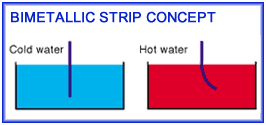
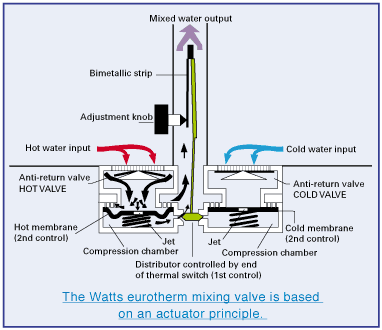
LEGIONELLA : FAQ (FREQUENTLY ASKED QUESTIONS)

What is legionnaires' disease ?
Legionnaires' disease is a bacterial disease which
may cause pneumonia.
The majority of cases are reported as single (isolated)
cases but outbreaks can occur.
Why is it called legionnaires' disease ?
An outbreak of this disease in Philadelphia in 1976,
among people attending a state convention of the American Legion and led to
naming the disease after this group. Subsequently, the bacterium causing the
illness was identified and named Legionella pneumophila.
Is this a new disease ?
No. While the bacterium was only recently identified,
cases have been confirmed as far back as 1947 and some probably occurred before
then.
How widespread is the disease ?
Cases have been reported from all industrialised
countries. Around 200 cases are reported each year in England.
Where are legionella organisms found ?
Legionellas are widely distributed in the environment.
They have been found in ponds, hot and cold water systems, and water in air
conditioning cooling systems.
How is legionnaires' disease spread ?
The disease is spread through the air from a water
source. Person to person transmission does not occur. Breathing in aerosols
from a contaminated water system is the most likely route of transmission.
Who gets legionnaires' disease ?
All ages can be affected but it mainly affects people
over 50 years of age, and generally men more than women.
What are the symptoms ?
The early symptoms of legionnaire’s disease include
a 'flu-like' illness with muscle aches, tiredness, headaches, dry cough and
fever. Sometimes diarrhoea occurs and confusion may develop.
These symptoms frequently lead on to pneumonia.
Deaths occur in 10-15% of otherwise healthy individuals and may be higher in
some groups of patients.
How soon do symptoms occur ?
The incubation period ranges from 2 to 10 days but
is usually 3 to 6 days.
In rare cases some people may develop symptoms as late as three weeks after
exposure.
What is the treatment ?
Antibiotics are effective in treating the disease.
How is it diagnosed ?
A rapid diagnosis can be made by testing an urine sample
from the patient, once the relevant symptoms have occurred.
Top of page
KEY POINTS TO PREVENT
LEGIONELLA
All over Europe, the Legionella disease changes habits
and National Regulations.
Main contamination by Legionella is due to evaporative condensers and air conditioning
systems (cooling towers), spa pool and spray humidifiers or air washers.
Water systems may occasionally be contaminated by Legionella which enters
cold water storage systems from the main supply.
Legionella will only grow in sanitary distribution network when there are
increased temperature, appropriate nutrients and stagnation.
The sanitary network has to comply with the national regulations.
Analysis of water samples for Legionella should be carried out regularly.
The main keys points of the Regulation are* :
- 2 methods for fighting against these bacteria : thermal
shock or chemical shock
- increased hot temperature from the heater (use water heaters with minimal
or no storage)
- all storage water heaters should have a drain valve located in an accessible
position at the lowest point
- of the vessel (accumulated sludge can be drained
easily)
- permanent chemical treatment must be avoided
- use of recirculation systems : circulating loops
- ensure that the target temperature is achieved throughout all levels of
the loop
- mixing valves must be as close as possible to the point-of-use
- mixing valves must have integrated check-valves
- equipment must allow easy cleaning and disinfection operation
- if a single mixing valve serves a multiple showerheads, these showers must
be flushed frequently
- circulating loop should be designed to return the mixed water to the storage
not less than 50°C*
- (55°C for Belgium and UK - 60°C for The
Netherlands)
- hot and cold water distribution pipes must be insulated sufficiently (never
together)
- dismantle and clean hoses, tap, showerheads and mixing valves minimum once
a year
- * according to National Regulation
Top of page